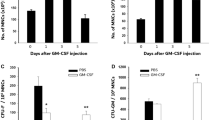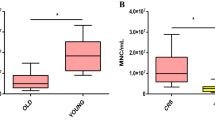Abstract
Granulocyte colony—stimulating factor (G-CSF) has been shown to affect the biochemical markers of bone metabolism, including serum bone alkaline phosphatase (BALP), serum osteocalcin, and urine deoxypyridinoline. To determine the association between bone resorption and formation and the G-CSF—induced mobilization of peripheral blood stem cells (PBSC), we examined these markers during mobilization in 19 healthy donors. The average (± SEM) serum BALP level before treatment was 81.6 ± 17.0 IU/dL, and the level increased significantly to 117.7 ± 15.8 IU/dL on day 5 of G-CSF administration (P < .0001). The urine deoxypyridinoline level before treatment was 12.3 ± 2.4 nmol/mmol creatinine, and this level also increased significantly to 19.4 ± 3.0 nmol/mmol creatinine on day 5 of G-CSF administration (P < .0001). In contrast, the average level of serum osteocalcin significantly decreased from 8.07 ± 2.88 ng/mL to 1.53 ± 0.18 ng/mL on day 5 (P = .0353). During G-CSF administration, we also studied the serum levels of various cytokines (IL-lβ, osteoclastogenesis inhibitory factor [OCIF], IL-6, tumor necrosis factor a, transforming growth factor β, interferon-γ, macrophage colony—stimulating factor) related to bone metabolism. Only the kinetics of OCIF were significantly affected. The serum level of OCIF increased immediately after the start of G-CSF administration and remained high during G-CSF administration. These results demonstrate that high-dose G-CSF affects bone metabolism and that OCIF may play a role in bone metabolism. Consistent with the notion that G-CSF affects bone metabolism, a significant correlation was observed between CD34+ cell yield and the increase in urine deoxypyridinoline but not for the changes in serum BALP and osteocalcin levels. This result suggests that bone resorption is either directly or indirectly related to the mobilization of PBSC by G-CSF.
Similar content being viewed by others
References
To LB, Haylock DN, Simmons PJ, Juttner CA. The biology and clinical uses of blood stem cells.Blood. 1997;89:2233–2258.
Anderlini P, Przepiorka D, Champlin R, Körbling M. Biologic and clinical effects of granulocyte colony-stimulating factor in normal individuals.Blood. 1996;88:2819–2825.
Engelhardt M, Bertz H, Alting M, et al. High-versus standard-dose filgrastim (rhG-CSF) for mobilization of peripheral-blood progenitor cells from allogeneic donors and CD34+ immunoselection.J Clin Oncol. 1999;17:2160–2172.
de la Rubin J, Martínez C, Solano C, et al. Administration of recombinant human granulocyte colony-stimulating factor to normal donors: results of the Spanish National Donor Registry. Spanish Group of Allo-PBT.Bone Marrow Transplant. 1999;24:723–728.
Snowden JA, Biggs JC, Milliken ST, et al. A randomized, blinded, placebo-controlled, dose escalation study of the tolerability and efficacy of filgrastim for hematopoietic stem cell mobilization in patients with severe active rheumatoid arthritis.Bone Marrow Transplant. 1998;22:1035–1041.
Bishop NJ, Williams DM, Compston JC, et al. Osteoporosis in severe congenital neutropenia treated with granulocyte colony-stimulating factor.Br J Haematol. 1995;89:927–928.
Takahashi T, Wada T, Mori M, et al. Overexpression of the granulocyte colony-stimulating factor gene leads to osteoporosis in mice.Lab Invest. 1996;74:827–834.
Lee MY, Fukunaga R, Lee TJ, et al. Bone modulation in sustained hematopoietic stimulation in mice.Blood. 1991;77:2135–2141.
Papayannopoulou T, Nakamoto B. Peripheralization of hemopoietic progenitors in primates treated with anti-VLA4 integrin.Proc Natl Acad Sci USA. 1993;90:9374–9378.
Lévesque JP, Leavesley DI, Niutta S, et al. Cytokines increase human hematopoietic cell adhesiveness by activation of very late antigen (VLA)-4 and VLA-5 integrins.J Exp Med. 1995;181:1805–1815.
Voermans C, Gerritsen WR, dem Borne AE, van der Schoot CE. Increased migration of cord blood-derived CD34+ cells as compared to bone marrow and mobilized peripheral blood CD34+ cells across uncoated or fibronectin-coated filters.Exp Hematol. 1999;27:1806–1814.
Petit I, Szyper-Kravitz M, Naglar A, et al. G-CSF induces stem cell mobilization by decreasing bone marrow SDF-1 and up-regulating CXCR4.Nat Immunol. 2002;3:687–694.
Möhle R, Murea S, Kirsch M, Hass R. Differential expression of L-selectin, VLA-4, and LFA-1 on CD34+ progenitor cells from bone marrow and peripheral blood during G-CSF-enhanced recovery.Exp Hematol. 1995;23:1535–1542.
Watanabe T, Kawano Y, Kanamaru S, et al. Endogenous interleukin-8 (IL-8) surge in granulocyte colony-stimulating factor-induced peripheral blood stem cell mobilization.Blood. 1999;93:1157–1163.
Roodman GD. Cell biology of the osteoclast.Exp Hematol. 1999;27:1229–1241.
Jimi E, Shuto T, Koga T. Macrophage colony-stimulating factor and interleukin-1 alpha maintain the survival of osteoclast-like cells.Endocrinology. 1995;136:808–811.
Fuller K, Owens JM, Jagger CJ, et al. Macrophage colony-stimulating factor stimulates survival and chemotactic behavior in isolated osteoclasts.J Exp Med. 1993;178:1733–1744.
Pfeilschifter J, Chenu C, Bird A, et al. Interleukin-1 and tumor necrosis factor stimulate the formation of human osteoclast-like cells in vitro.J Bone Miner Res. 1989;4:113–118.
Murray RE, McGuigan F, Grant SF, et al. Polymorphisms of the interleukin-6 gene are associated with bone mineral density.Bone. 1997;21:89–92.
Zhou H, Choong PC, Chou ST, et al. Transforming growth factor beta 1 stimulates bone formation and resorption in an in-vitro model in rabbits.Bone. 1995;17:443S-448S.
Fujita T, Mastui T, Nakao Y, et al. Cytokines and osteoporosis.Ann N Y Acad Sci. 1990;587:371–375.
Yasuda H, Shima N, Nakagawa N, et al. Identify of osteoclastogenesis inhibitory factor (OCIF) and osteoprotegerin (OPG): a mechanism by which OPG/OCIF inhibits osteoclastogenesis in vitro.Endocrinology. 1998;139:1329–1337.
Delmas PD. Biochemical markers of bone turnover.J Bone Miner Res. 1993;8(suppl 2): S549-S555.
Heissig B, Hattori K, Dias S, et al. Recruitment of stem and progenitor cells from the bone marrow niche requires MMP-9-mediated release of kit-ligand.Cell. 2002;109:625–637.
Janowska-Wieczorek A, Marquez LA, Dobrowsky A, Ratajczak MZ, Cabuhat ML. Differential MMP and TIMP production by human marrow and peripheral blood CD34+ cells in response to chemokines.Exp Hematol. 2000;28:1274–1285.
Lévesque JP, Takamatsu Y, Nilsson S, Haylock DN, Simmons PJ. Vascular cell adhesion molecule-1 (CD106) is cleaved by neu- trophil proteases in the bone marrow following hematopoietic progenitor cell mobilization by granulocyte colony-stimulating factor.Blood. 2001;98:1289–1297.
Bonilla MA, Dale D, Zeidler C, et al. Long-term safety of treatment with recombinant human granulocyte colony-stimulating factor (r-metHuG-CSF) in patients with severe congenital neutropenias.Br J Haematol. 1994;88:723–730.
Soshi S, Takahashi HE, Tanizawa T, et al. Effects of recombinant human granulocyte colony-stimulating factor (rh G-CSF) on rat bone: inhibition of bone formation at the endosteal surface of vertebra and tibia.Calcif Tissue Int. 1996;58:337–340.
Morris HA, Chatterton BE, Ross PD, Durbridge TC. Diagnostic procedures. In: Need AG, Morris HA, eds.Metabolic Bone and Stone Disease. Edinburgh, UK: Churchill Livingstone; 1993:339–379.
Takamatsu Y, Simmons PJ, Moore RJ, et al. Osteoclast-mediated bone resorption is stimulated during short-term administration of granulocyte colony-stimulating factor but is not responsible for hematopoietic progenitor cell mobilization.Blood. 1998;92:3465–3473.
Shinar DM, Sato M, Rodan GA. The effect of hematopoietic growth factors on the generation of osteoclast-like cells in mouse bone marrow cultures.Endocrinology. 1990;126:1728–1735.
Author information
Authors and Affiliations
Corresponding author
About this article
Cite this article
Watanabe, T., Suzuya, H., Onishi, T. et al. Effect of Granulocyte Colony-Stimulating Factor on Bone Metabolism During Peripheral Blood Stem Cell Mobilization. Int J Hematol 77, 75–81 (2003). https://doi.org/10.1007/BF02982606
Received:
Accepted:
Published:
Issue Date:
DOI: https://doi.org/10.1007/BF02982606




